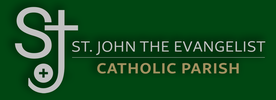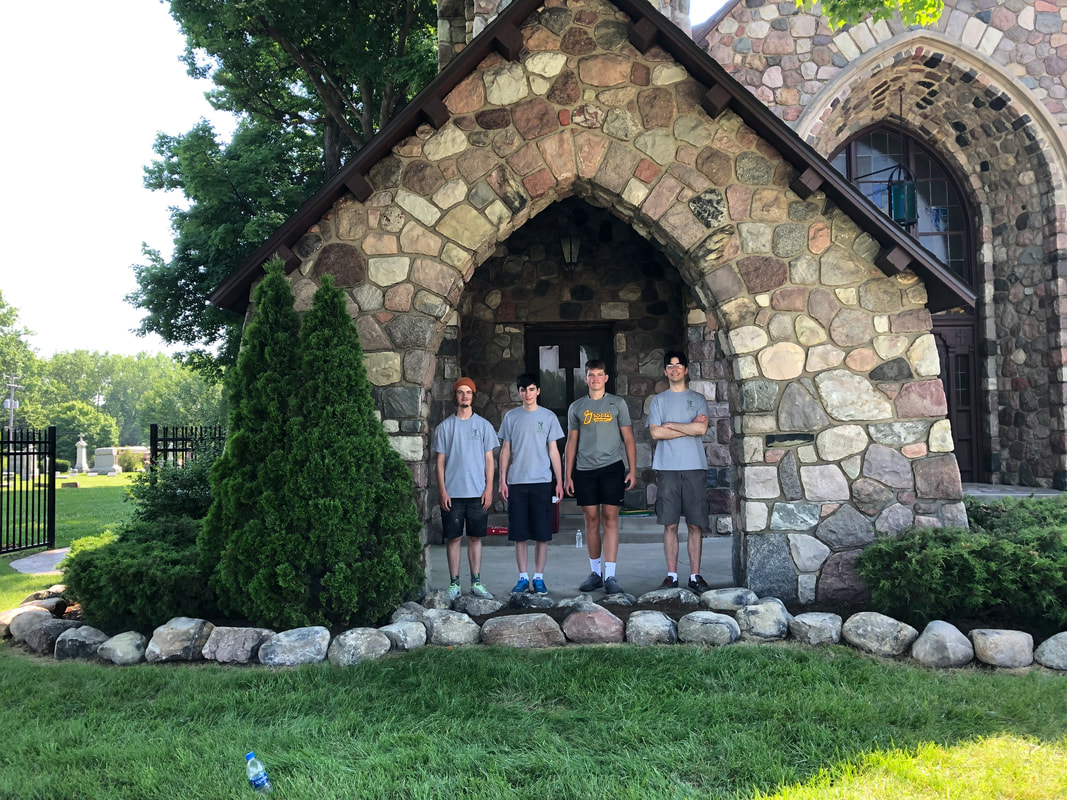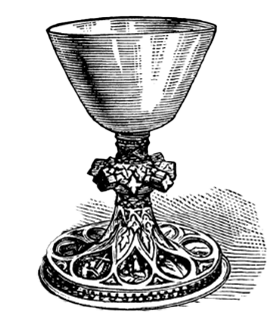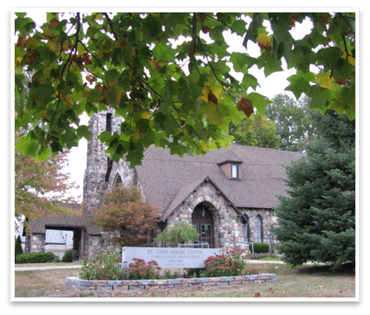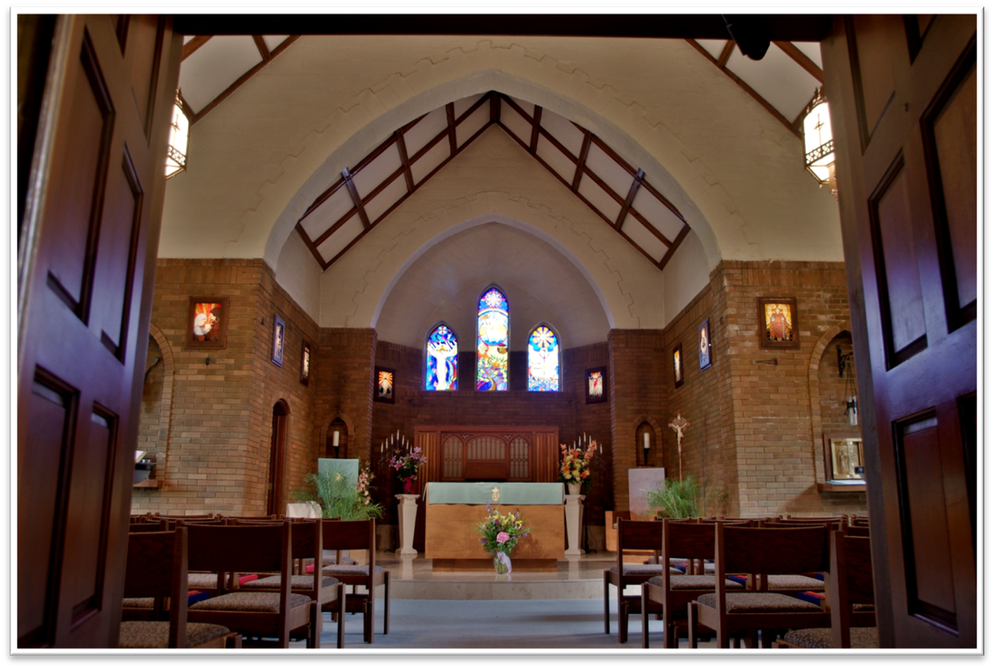History of the Chapel
This beautiful stone building pictured above, a.k.a. ’The Old Stone Chapel,’ was an architectural gem of the diocese of Detroit (as the diocese of Lansing did not exist when it was built) and is a historical landmark in the City of Fenton. It replaced the original frame church, and was dedicated on August 8, 1928. At that time, the cost was $50,000, which is equivalent to $937,031.58 today. What became our parish's second church building was the inspiration of Fr. David Dillon. He was recognized for developing the plan for an architecturally harmonious church, rectory, and grounds. He was succeeded by Fr. Maurice Walsh, both a pastor and a builder, who transformed this vision into reality. The Chapel's Tudor Gothic style was modeled after a Catholic Church in a small village in France. The structure was made from materials provided by parishioners and other local families from their own fields and woodlands. Many of you remember or have heard stories passed down from fathers, grandfathers, or others, of bringing materials to the construction site or helping to build the church with their own hands. Only the electrical work and plumbing were done with outside help. In Europe, stone buildings like our Chapel last for centuries.
The chapel served as our church through 1965, was converted to a gym when our present church was built, and later into office space and a small chapel. Once renovated the chapel seated up to 80 people and was used for weekday masses, adoration, small weddings and funerals. It was a refuge - a place to pray and reflect in an intimate setting. In 2016, in need of critical repairs, the artifacts and fixtures were removed, the offices relocated and the doors closed. It has since been vacant. When walking through the empty shell of the church, even I, a newcomer, feel its historical relevance to the parish and community.
Many have asked what will happen to this beautiful building we call the chapel. Over the past months we held discussions about this with the Parish and Finance Councils and with their approval, engaged the architectural firm Sedgwick and Ferweda, requesting an estimate to restore it as a fully functional worship space. Both councils recommended that we survey your input to determine if it's a priority, and ask for your guidance on how to proceed.
Fr. Robert and I asked the architect to quote a modest remodel with options to complete the project in phases. The architect quoted the project slightly over $1,000,000 (coincidentally, close to the equivalent price of the original building) and fairly represented the skyrocketing building costs related to COVID, warning that, historically, prices do not return to pre-catastrophe levels but should stabilize. We currently have approximately $150,000 earmarked for “Chapel Renovations.” We recently discussed the idea of adding columbarium space to the chapel if the decision is made to proceed with the restoration. We have only a few spaces remaining in the existing columbarium. While this will likely raise the price of restoration, it will also defray some construction costs. We would like to know your thoughts.
Please review the survey and pray about how you should respond. Consider how this decision will affect your family and the members of St. John Parish for future years. You can submit your responses online at the links above and below.
Please submit your response by June 27.
Carla Ward
Operations Manager
The chapel served as our church through 1965, was converted to a gym when our present church was built, and later into office space and a small chapel. Once renovated the chapel seated up to 80 people and was used for weekday masses, adoration, small weddings and funerals. It was a refuge - a place to pray and reflect in an intimate setting. In 2016, in need of critical repairs, the artifacts and fixtures were removed, the offices relocated and the doors closed. It has since been vacant. When walking through the empty shell of the church, even I, a newcomer, feel its historical relevance to the parish and community.
Many have asked what will happen to this beautiful building we call the chapel. Over the past months we held discussions about this with the Parish and Finance Councils and with their approval, engaged the architectural firm Sedgwick and Ferweda, requesting an estimate to restore it as a fully functional worship space. Both councils recommended that we survey your input to determine if it's a priority, and ask for your guidance on how to proceed.
Fr. Robert and I asked the architect to quote a modest remodel with options to complete the project in phases. The architect quoted the project slightly over $1,000,000 (coincidentally, close to the equivalent price of the original building) and fairly represented the skyrocketing building costs related to COVID, warning that, historically, prices do not return to pre-catastrophe levels but should stabilize. We currently have approximately $150,000 earmarked for “Chapel Renovations.” We recently discussed the idea of adding columbarium space to the chapel if the decision is made to proceed with the restoration. We have only a few spaces remaining in the existing columbarium. While this will likely raise the price of restoration, it will also defray some construction costs. We would like to know your thoughts.
Please review the survey and pray about how you should respond. Consider how this decision will affect your family and the members of St. John Parish for future years. You can submit your responses online at the links above and below.
Please submit your response by June 27.
Carla Ward
Operations Manager
History of the Chapel
|
In 1868 two acres of ground was purchased from William and Jane Remington for $400 and a building committee organized. The first church was a wooden structure which was dedicated in 1879. In 1927 construction of the fieldstone church began, and was dedicated in August of 1928.
Once our current church was built the chapel was used as a gymnasium for the school among other things. When Fr. Harvey was assigned to St. John’s in 1979 the parish was in need of office space. The chapel was beautifully restored, using many original artifacts such as the tabernacle, in 1981. Later an enclosed hallway was added to connect the rectory with the chapel. |
|
REDEDICATION MASS: L to R - Andy Finn (Thurifer), Fr. John J. Blanchard S.J., Associate Pastor, Fr. David W. Harvey, Pastor, Bishop Kenneth J. Povich, Fr. Bernard Reilly, Associate Pastor, In Foreground, Deacon Thomas D. Nenneau (Intern) and Chris Anderson, Acolyte, August 23, 1981.
|
RIGHT: Dan Nichols, native son of parishioners Harold & Norma (Jo) Nichols by the altar beneath stained glass windows in Chapel which he designed. 1984
|
|
The original stone church was closed in 1966 after the new church was dedicated. For years it was used as a gymnasium for St. John children and young people of the parish. Rev. Fr. David Harvey was the pastor during the reconstruction of the old stone church. The weekend of January 12-13, 1980 was designated as "Pledge Weekend." The theme of the project was "Appreciating the past, giving to the future." The estimated cost to renovate was $200,000. The rededication mass was August 23, 1981. The original sanctuary and front nave area were restored as an active chapel for daily liturgy, daily visitation, and small liturgical gatherings. Six offices for priests secretaries, the bookkeeper and the music minister were built into the original nave area. Two separate entries were made, one for the chapel and one for the office area.
|
